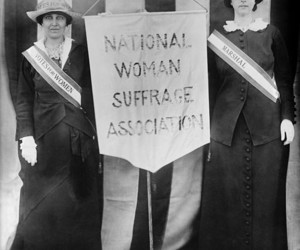In the modern era of democracy, women in countries around the world have struggled and fought to gain the right to vote alongside men. They have faced barriers to voting not only based on gender, but also on race, wealth, and education.
It’s difficult to generalize about the history of woman suffrage since suffrage movements around the world have been very different in their views, goals, and methods. Many groups peacefully and effectively passed out flyers and held conferences like the Women’s Suffrage League in Japan. On the other hand, militant groups like the Women’s Social and Political Union in the United Kingdom smashed shop windows, bombed public buildings, and used prison hunger strikes when arrested.
People even had different motives for wanting women to have the vote. In many societies, women were thought to be naturally kinder, gentler, and it was thought that their vote would help society to become more peaceful and civilized. Some people believed that everyone should have the right to vote, regardless of gender, race, or social status. Still others wanted the votes of white women to cancel out the votes of non-white men.
Regardless of motives and strategies, the vast majority of women’s suffrage movements around the world have been successful in the past hundred years.
Suffrage for Women in Europe
The very first example of women’s suffrage around the world was in the short-lived Corsican Republic. The small island declared itself independent in 1755 and granted universal suffrage to its inhabitants, but it only lasted until 1769 when the French took over the island. Modern movements for suffrage for women began as early as during the French Revolution with a Women’s Petition to the National Assembly demanding equal rights for women.
Sweden and Finland became the first modern countries in Europe to grant women limited voting rights in the 1860s. Norway and Denmark followed suit in 1913 and 1916 respectively, and most other countries right after World War I. France, despite its early role in the movement, waited until 1944, and Liechtenstein was the last in 1984.
Oceania Women Suffrage Movement
Though still a colony of Britain at the time, New Zealand granted women the right to vote in 1893 after successful campaigning by women such as Kate Sheppard. In 1902, Australia did the same, and also granted women the right to run for office. Still, some restrictions on the rights of Aboriginal women weren’t completely lifted until the 1960s.
Some women refused to obey the laws depriving them of voting rights, and disguised as men to participate in elections. Charley “Parkie” Parkhurst, a cross-dressing stagecoach driver, voted as a man in California in 1868. In 1871, 200 black women dressed in men’s clothing to register and vote in a North Carolina election.
Woman Suffrage in North America
In the United States, laws on voting differed from state to state. In some areas, women were granted the right to vote much earlier than the rest of the nation. Wyoming was the first state to permanently grant women suffrage in 1869. The United States Constitution avoided the subject, and it wasn’t until the 19th Amendment was passed in 1920 that all women in the United States were legally able to vote.
Canada also had different voting laws depending on the province. Some women had voting rights in Ontario as early as 1850. The Canadian Women’s Suffrage Association, formed in 1883, began to present bills to parliament throughout the next few decades, but they were ignored at first. By 1918, though, women were able to vote in every province except Quebec, which held out until 1940.
Asian and African Women Rights to Vote
The women’s suffrage movement in Japan thrived beginning in the 1920s, but it wasn’t until 1945 that the law was revised to allow women to vote. In 1947, women in China also gained voting rights with the implementation of the Constitution of the People’s Republic of China.
In Asia, Azerbaijan became the first Muslim country to enfranchise women when it granted universal suffrage to its citizens in 1918. Women in the country of Georgia voted a year later in 1919. In many countries in Africa, men and women gained the right to vote at the same time, such as in Liberia in 1947 and Uganda in 1958.
Suffrage for Women of Latin America
Among Central and South American countries, Ecuador became the first to grant women suffrage in 1929. Still, voting was optional for women but compulsory for men until 1967, when voting became compulsory for women as well. Most Latin American countries gave women the right to vote in the 1930s, 40s, and 50s.
Today, women still don’t have the right to vote in some countries. Many of these are non-democratic where both men and women can’t vote, like in the sultanate of Brunei. In some countries where women can vote, there are still restrictions: in Lebanon, women can only vote if they have at least an elementary education, but there are no education restrictions on men.
In the vast majority of nations around the world, however, women have gained the right to vote and have made a difference with their vote: In the decades after women gained voting rights in Australia, divorce laws became more equitable and laws granted women more equal pay in some professions. Polls and studies in the United States have shown that women’s votes tend to lead to more progressive tax systems, more educational spending, and more liberal policies in general. Around the world, women’s suffrage movements have made a difference not only in granting basic human rights to women, but in improving the lives of their fellow citizens.


